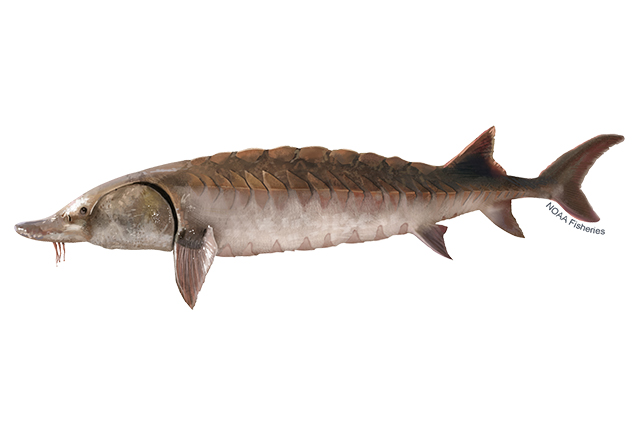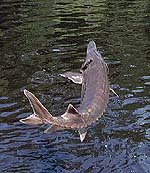Mark Twain once said – “Everyone talks about the weather, but no one does anything about it.” A similar statement could be made about the Gulf Sturgeon – “Everyone talks about the Gulf sturgeon, but on one has actually seen one.” Those along the coast who have a dock, pier, seawall, or have placed a marina, artificial reef, or oyster farm over state submerged lands, have certainly heard about this fish. It is a portion of the permit in each case. Heck, maybe they have seen one. But it is a fish that many know about but seems elusive to encounter.

The Gulf sturgeon (Acipenser oxyrinchis desotoi) is one of 27 species of sturgeon found worldwide. It is a subspecies of the Atlantic sturgeon. These are ancient fish, and they look it. Sturgeons are large, reaching lengths of up to eight feet and 300 pounds. They have armored looking scutes embedded into their skin, giving them a “dinosaur” appearance. They have a heterocercal caudal fin that resembles a shark. And like sharks, they have a cartilaginous skeleton and a spiral valve within their digestive tract. Their head has a pointed snout with whisker-like structures called barbels, which are used for detecting food buried in the sand, and they lack teeth. They have been swimming in our oceans since the era of the dinosaurs, about 225 million years.
Sturgeons are anadromous fish, meaning they (like salmon) spend their adult lives in salt water, traveling miles upriver to their location of their birth to lay eggs. The Gulf sturgeon spends the colder months (November through February) inhabiting our bays and the nearshore Gulf of Mexico in waters less than 100 feet. Now is the time when you may encounter one near the coast. Because they eat very little while in the river systems, they gorge on benthic invertebrates during the winter. They spend most of their time over sand flats and sand bars, using their barbels to detect a variety of buried invertebrates. When sturgeon since warmer months coming, they begin their long migrations up the inland rivers seeking the area where they were born. At this time, they leap from the water like mullets and make splashes that can be heard from a long distance. They are famous for this in the Suwannee River and have, at times, been a concern for boaters and jet skiers. Many have had to go to the hospital due to collisions with leaping sturgeon.

Photo: U.S. Geological Survey
Once they reach the spawning grounds, if conditions are right – temperature, water flow, and pH – the female will lay between 250,000 – 1,000,000 eggs which will become fertilized by the smaller males. Most eggs will not survive but for those that do, the cycle will begin again with the trek back towards the Gulf of Mexico beginning in September.
Why are they declining?
Early in the 20th century they were sought after for their meat and fertilized eggs (caviar). Most of the rivers within their range (which is between the Mississippi and Suwannee Rivers) have been damned, dredged, or both. Dams impede their ability to reach their nursery grounds and dredging can reduce the required conditions to stimulate breeding, or literally bury their eggs. Between these human activities, their numbers declined drastically. In 1991 they were listed both as a federally and state threatened species and have been protected and monitored ever since. The best population, and best chance to encounter one, is in the Suwannee River. This river has been left basically pristine and has not had the habitat altering activities of the others. Locally, they are found in the Escambia, Blackwater, and Yellow Rivers.
Winter is the time to see them in the lower parts of our bay. Maybe you will be lucky enough to encounter one.
References
The Gulf Sturgeon. Florida Fish and Wildlife Conservation Commission.
The Gulf Sturgeon. National Oceanic and Atmospheric Administration.
https://www.fisheries.noaa.gov/species/gulf-sturgeon.
 4
4
